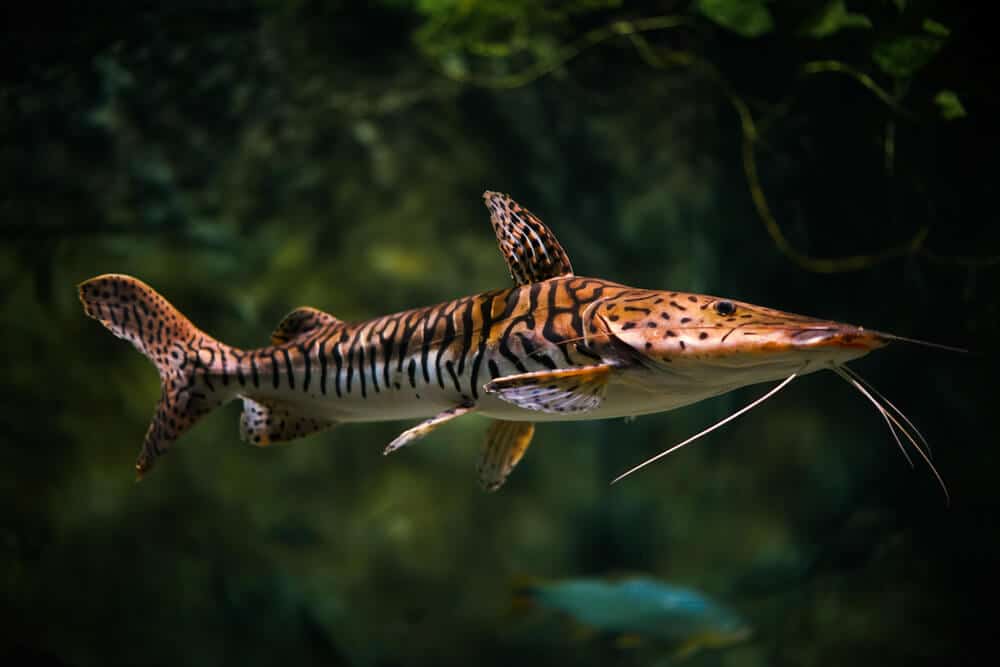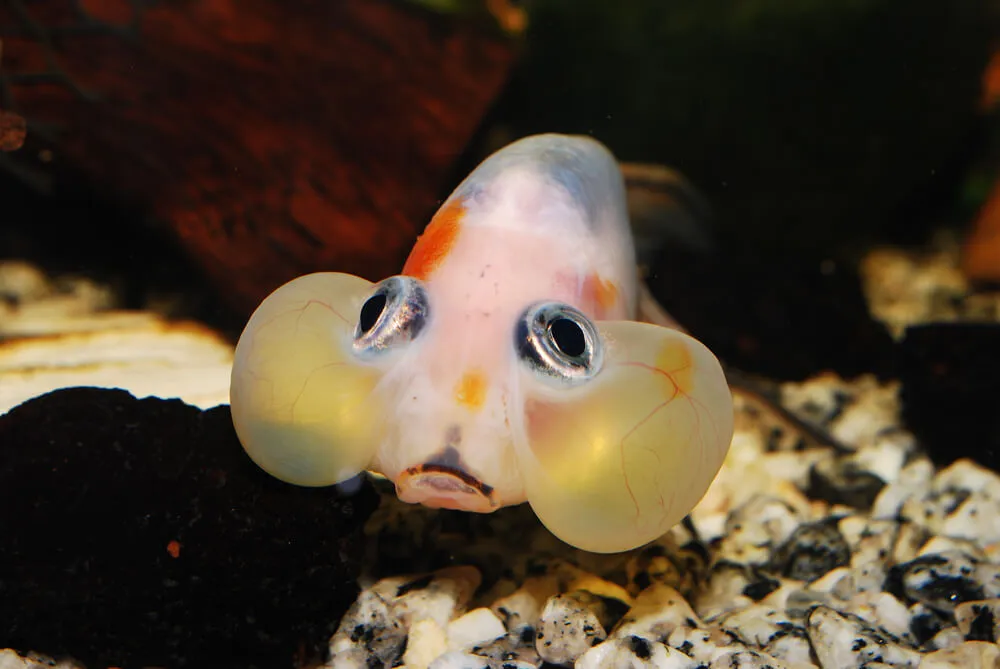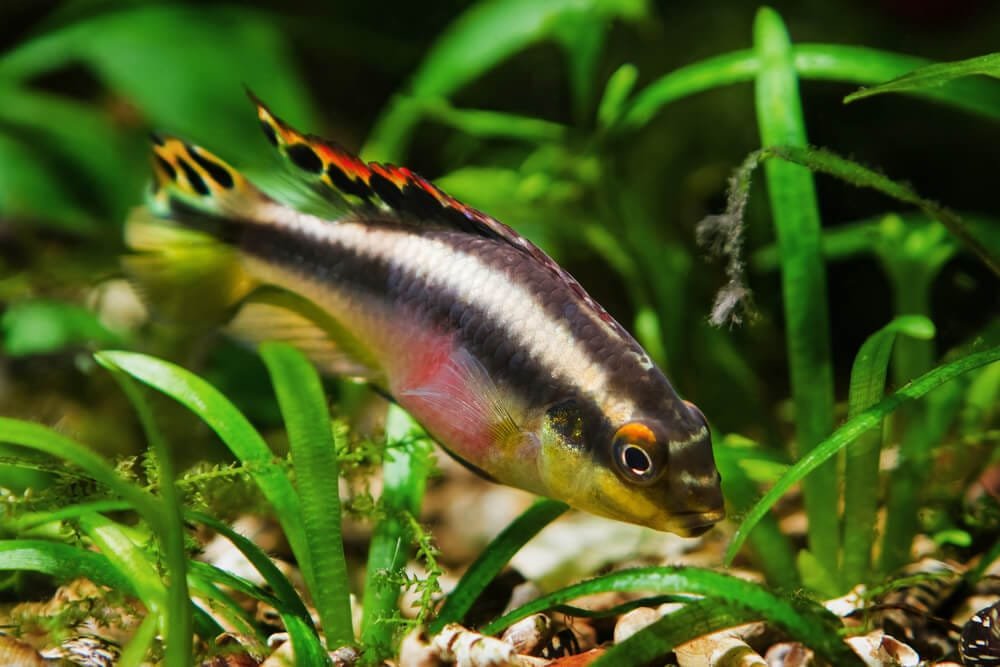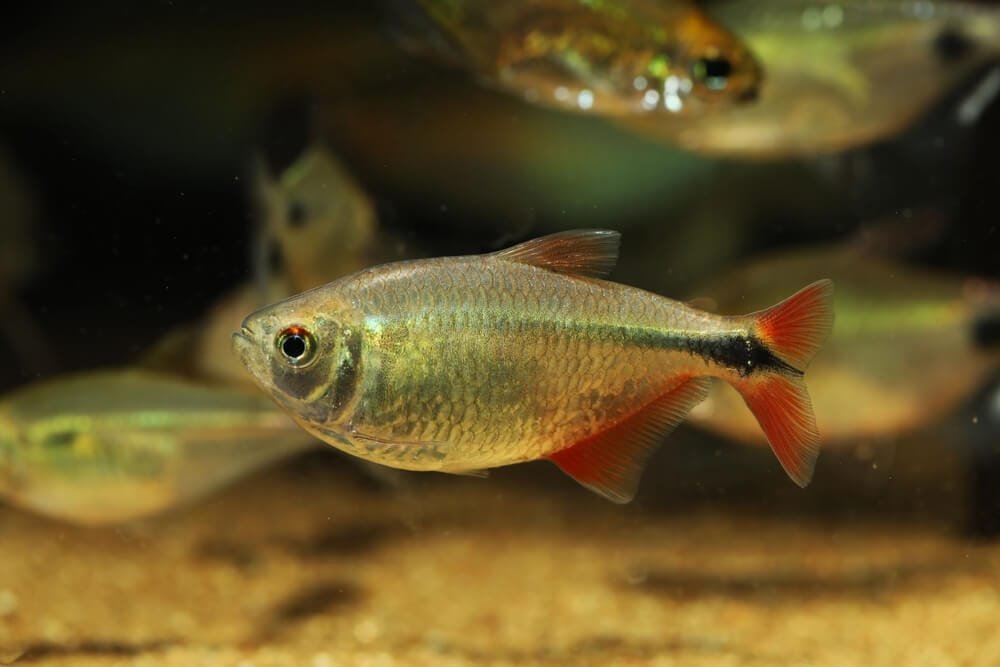Golden Chinese Algae Eater: Size, Tank, Breeding And Care Guide
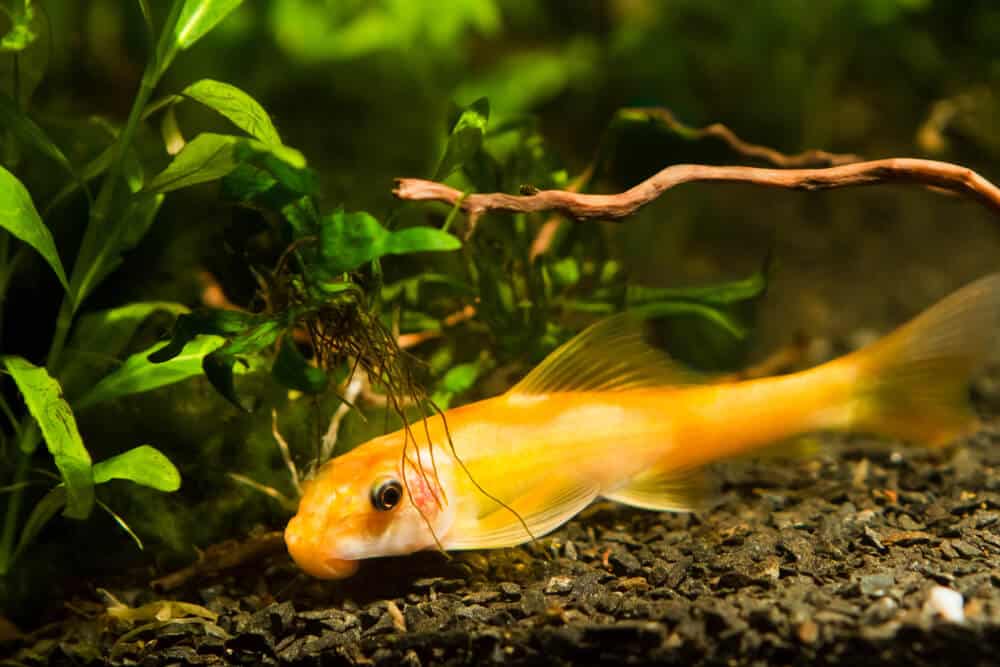
The Golden Algae Eater, better known in the Latin science community as the Gyrinocheilus aymonieri, hails from the Chinese Algae Eater family.
Ironically enough, this species does not inhabit China. Instead, you can mostly find them in farms and in mountain streams or lakes that flow over large parts of Southeast Asia such as Thailand and some parts in Laos, Cambodia, and Vietnam.
Some even claim that they were originally found in Northern India. With its eye-catching yellow/golden-colored scales, the Golden Chinese Algae Eater could not have been more aptly named.
These days, Chinese Algae Eaters caught in the wild are no longer being exported. The ones you see on sale in your local pet stores were most likely bred from fish hatcheries.
Its Latin name actually originated from the Greek words gyrinos, which means “tadpole”, and cheilos, which means “lip”. This is due to the Golden Algae Eater being a bit triangle-shaped, similar to the mouth shape of a tadpole.
The second name aymonieri, on the other hand, is in honor of the French linguist and researcher Étienne François Aymonier.
Being the suckermouth catfish that it is, the Chinese Algae Eater lives off of algae and algae wafers. This makes them not only fun, unique-looking pets but also useful to anyone having trouble dealing with algae in their aquariums! However, puberty is not only something humans deal with as it seems to be the case for Golden Algae Eaters as well.
When a Chinese Algae Eater reaches adulthood, it changes its dietary preferences and starts fancying more live food. So don’t be surprised when your Golden Algae Eater starts nipping at the scales of its fellow aquarium dwellers.
Lifespan And Appearance
The typical lifespan of a Golden Algae Eater is around 10 years. As is always the case, a lot of factors can contribute to its overall lifespan. Some of the factors that greatly contribute to this are its environment and diet.
Its appearance is also affected depending on the conditions of its environment and diet, ranging from a light yellow to a deeper yellow/goldfish coloration. Their best coloration is exhibited in an aquarium with plenty of driftwood and live plants.
Aquarium Care
You don’t need a ton of experience in fish care to figure out how to raise a Chinese Algae Eater. This makes them ideal for those who are just starting out and have no experience at all in fish caring.
Nonetheless, there are still a few things you need to keep in mind to ensure they stay healthy and happy. Some of them are as follows:
1. Tank Size
One of the things to consider is how big can your Golden Algae Eater get?
On average, they can grow to a maximum of 12 inches or 30 centimeters at full maturity. The tank size recommended for Golden Chinese Algae Eaters is a large aquarium that can hold around 150 liters or larger, especially if you want them to grow fully in a favorable environment with plenty of plants, rocks, and driftwoods for hiding.
2. Water Parameters
As for water conditions, the temperature should be kept at around 21°C-26°C or 70°F-79°F. A pH level between 6.8 and 7.4 is also recommended for tanks housing Golden Algae Eaters.
Despite the fact that this species can clean up some of the algae in tanks, it’s not healthy to slack on the maintenance and rely on the Chinese Algae Eaters’ snacking tendencies.
Always remember that it’s still just as important to stay on top of water conditions. Keep them in overall clean water with some algae to keep them fed throughout the day.
Water parameters also need to be maintained and consistently monitored to ensure they stay within the recommended conditions.
Though this species does have the capability to adapt to different aquarium conditions, it’s still important for the water parameters to stay constant to minimize stress on the Chinese Algae Eater.
3. Tank Environment
Investing in the enrichment of their habitats can also go a long way in keeping your Golden Algae Eaters happy. The key is to mimic their natural habitat, which, besides the typical decorations of rocks and plants, also means large stones, caverns, and fine sand. Sand is also the better option as it is less likely to scratch your fish than gravel.
It’s important to remember that this species dwells in rivers and streams that have field stones, gravel, pebbles, and sand.
The Golden Chinese Algae Eaters also often perform seasonal migration. Usually they end up in more muddy waters and sometimes even in flooded coastal areas.
They spend most of their time on solid flat surfaces. Smooth rocks are also recommended as they collect aquarium algae over time for the Golden Chinese Algae Eaters to feed on.
Considering they are natural mountain dwellers, it is important to have a powerful canister filter in your tank. It will make sure that the water stays clean and rich in oxygen. Some water flow would also be desirable.
As for lighting, moderate to normal lighting is preferred for this species.
At the top of your tank, it’s important to have a tight-fitting lid. Golden Algae Eaters are notorious for jumping up and using their powerful sucker-mouth to escape.
Chinese Algae Eaters can grow to be moderately large, but it’s generally at a slower rate than others. They can also tolerate both slow and fast flowing waters.
Although if you decide to house them in an aquarium with fast flowing water, then it’s important to make sure they have plenty of rocks and driftwoods to cling to.
Additionally, you should take extra caution with them especially when they grow larger. They can end up dislodging the plants and rocks in your aquarium.
4. Tank Maintenance
Weekly cleaning of your aquarium is recommended and important to keep your fish healthy. Use an aquarium vacuum when removing fish waste and decomposing organic matter from the tank.
It’s also recommended to change 25% to 30% of the water in the aquarium each week. Doing this will keep the ammonia, nitrite, and nitrate levels at an amount recommended for your fish.
Also, remember to rinse the filter media in the tank water, free of sludge and change your filter cartridges when needed.
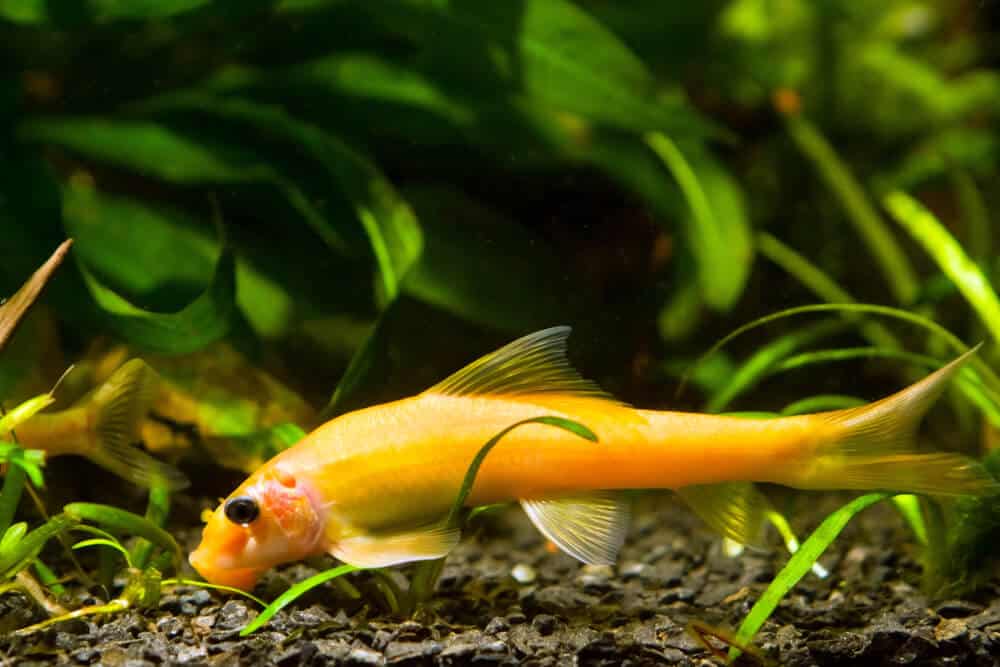
Feeding Recommendations
As mentioned before, a Golden Algae Eater’s food preferences tend to change when they mature. This is important to keep in the back of your mind when feeding your fish. However, Golden Chinese Algae Eaters are primarily herbivores that feed on algae that grow on rock, plants, driftwood, and aquarium glass.
If not enough algae are growing, they can be supplemented with algae wafers or fish pellets. This can actually be useful to feed them different types of food from time to time to keep them in good shape.
Younger species do fine feeding off algae, but as they grow older, they’ll start looking for more protein.
In the wild, they tend to feed on small maggots as well. But when they’re kept in an aquarium, feeding them with live or frozen food such as bloodworm, daphnia, or brine shrimp will be enough to sustain them.
You can also feed the younger ones with spinach, lettuce, and cabbage leaves that have been cleaned with boiling water. On the other hand, the mature ones can be fed with small crustaceans.
Quality dry food, such as fish pellets, is typically the best alternative option. This is because they maintain their structure for some time even after reaching the bottom of the tank. This helps the Golden Chinese Algae Eater easily scrape the slowly softening food that contains high quality nutrients such as spirulina.
The younger ones tend to be calm and peaceful. They do an excellent job of cleaning up the algae growing in an aquarium.
The adult species, on the other hand, are less inclined in this aspect and may even be more aggressive.
Frequency Of Feeding
The frequency of feeding your Golden Chinese Algae Eaters depends on the amount of algae growing in your tank at a given moment. The quantity should also be only as much as the fish will eat in a couple of minutes.
It’s important to feed them several times a day, but also pay close attention to whether they are hungry or not. If they stop eating the algae in the tank, either because they’re overfed or not hungry, then there’s no harm in not feeding them for a short period of time.
You should also pay attention to which food, besides algae, your Chinese Algae Eater prefers. When experimenting with different types of food, make sure you aren’t compromising the water quality of the tank.
Uneaten food can lead to an increase in the ammonia and nitrate levels in your tank which is not healthy for your fish.
Possible Diseases
There isn’t a disease that is only specific to this species that you need to watch out for in particular. But that doesn’t mean they’re immune to other health problems that a typical fish experiences.
One of those is Ich. Ich is a disease caused by stress, which can be attributed to poor water conditions. This is why there is a heavy emphasis on making sure your water conditions do not go below the recommended standards.
Golden Chinese Algae Eaters are also prone to bloat. This is a problem caused by overfeeding and should be taken seriously as it can lead to more serious digestive diseases.
The scaleless belly of this species also contributes to making them vulnerable to diseases.
Additionally, they are more sensitive to commonly-used fish medications. Thus, if you put them in a tank with other fish, remember to put a separate quarantine tank for your Chinese Algae Eater when treating your other fish.
There are a few signs that should alert you to your fish possibly having health problems. These signs include:
- Loss of appetite and not eating the algae on the surfaces of the tank
- Lethargic behavior
- Unnatural flicking or rubbing against aquarium decorations and the substrate
- Fins are either swelling or ripped
- Spending time at the surface of the water when they usually dwell at the bottom
Temperament
You can choose to keep your Golden Algae Eaters alone in a separate tank or with other fish. However, keep in mind that only the younger species tend to do fine in groups. When they mature, they become more aggressive and territorial.
For the most part, these Algae Eater fish spend their time hiding at the bottom of the tank alone. They are definitely more of a loner than other fish, thus you can’t expect to get a high entertainment value from them.
They can also be skittish, especially when you approach the tank suddenly or stick your hand in the water and end up hiding in the nearest cave.
Golden Chinese Algae Eaters do come out of hiding pretty quickly after you leave or even if you decide to stay and simply watch the tank.
They spend most of their time in the lower parts of the aquarium and stick to surfaces, feeding off of the algae around the tank.
Younger Golden Chinese Algae Eaters, in particular, tend to spend more time minding their own business and foraging around the bottom of the tank, which is why they make good community fish.
Once they have latched onto a surface of the tank, they will typically stay there for hours. This species of fish is also primarily nocturnal.
They are more active during the night and spend most of the daytime hours hiding and resting in caves or behind plants.
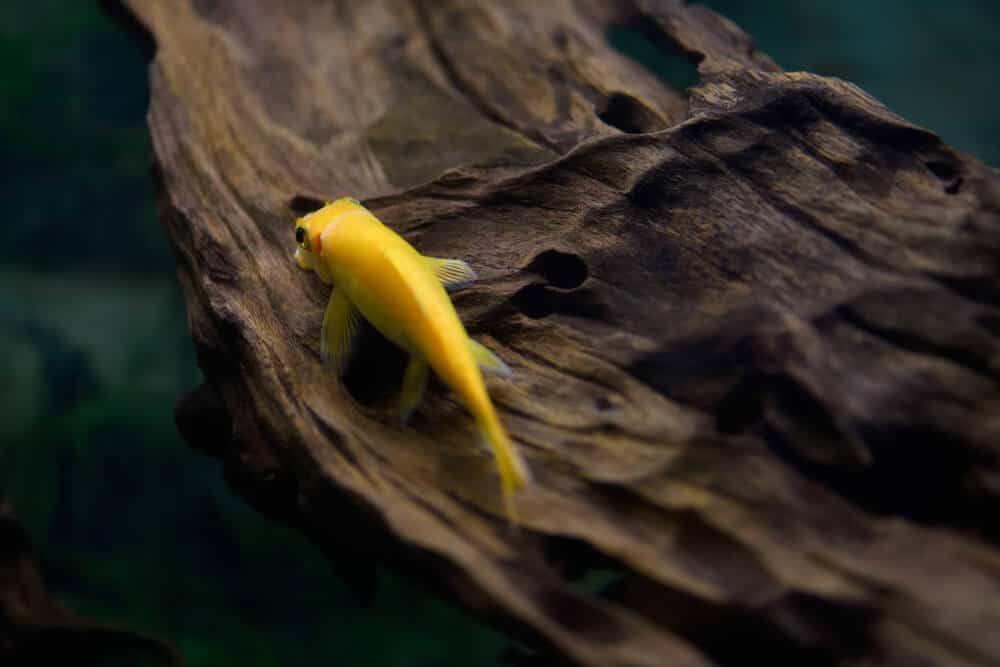
Compatibility With Other Fish
They’re easy to look after but they may show aggression towards tank mates of a similar shape and size, like the Silver Sharks and Red Tailed Sharks.
It’s also recommended to keep them away from a tank full of large, slow-moving fish that they are likely to chase.
You can get away with putting the larger species in a group.
The best tank mates you could choose from, in that case, are the small, speedy species that can swim away fast enough when they need to. Examples of these are the Tiger Barbs, Mollies, Swordtails, etc.
When choosing their tank mates, it’s important to be cautious. The Golden Chinese Algae Eaters may end up eating the body slime off of other fish, making them prone to diseases and infections. You could potentially avoid this by putting them in a large tank with a lot of food sources.
Additionally, you should make sure not to overcrowd the tank as this could only feed their aggression.
Gender Differences
Trying to tell the difference between a male Golden Algae Eater and a female Golden Algae Eater can be quite difficult and frustrating.
They grow to similar sizes and exhibit the same color. Even so, there have been a couple of things that have been observed to tell them apart. The thorns around the mouth of a male Chinese Algae Eater tend to grow and be more pronounced.
On the other hand, you can identify a female Chinese Algae Eater by the fact that they tend to develop a rounder belly than their male counterparts.
The reproductive male species also have another distinguishing feature which is a breeding horn on the top of their head.
Breeding
It has been proven to be very challenging to try and breed this species, especially at home. Only a few cases of it being done in home aquariums have been reported. It would require a more complicated setup with a large amount of vegetation which not only provides extra space but also mimics their natural environment, and proper knowledge and experience.
The Chinese Algae Eater typically becomes fertile when they reach 2 years old. Breeding them would require a separate tank without about 200 liters of water, good filtration, and a strong water flow.
You place a net on the bottom and some wide-leaved plants in the corners of the net. The light should be kept dim.
As for water conditions, its temperature should be at 24°C with a pH level of 6.0-8.8. 10% of the water in the tank should be renewed daily.
You then select a female with eggs and give them two hormonal injections — one before spawning and the second one when you put it in the tank. Two males are then placed in the tank with it.
Fertilization Of The Eggs
A female Chinese Algae Eater can lay up to 3,000 eggs that the males then fertilize. The breeders should be removed from the tanks once the eggs have been laid to start the incubation period.
This typically lasts a day and requires constant thorough care like daily small water renews, removing dead eggs, and adding antifungal agents in the water to help preserve the embryos.
The challenge also comes from keeping female and male Golden Chinese Algae Eaters, considering their tendencies to be aggressive even towards fish of their own species.
There are also almost no physical differences between them which makes it difficult to sex them for breeding.
If the more complicated setup isn’t for you, you can try raising the temperature to trigger the breeding process. This is a more commonly used method of breeding for other species.
Although it’s not as concrete of a method, there have been cases of aquarists succeeding by slowly raising the temperature of the water each day by 3°F until you reach 80°F which replicates the spawning temperature they experience at the end of spring.
Frequently Asked Questions
Are Golden Algae Eaters Aggressive?
When young, Golden Chinese Algae Eaters are typically more peaceful and can get along well with other fish. But when they mature, they can become semi-aggressive, especially towards fish of similar shape, size, or color.
There is a way of working around it by carefully picking which fish it is placed in a tank with.
How Big Do Chinese Algae Eater Get On Average?
A fully mature Golden Algae Eater can grow to a maximum of 12 inches or around 30 centimeters.
Can Algae Eaters Live With Goldfish?
No, it is not recommended for your goldfish to be in the same tank as an Algae Eater. This is due to the goldfish having a slime coat that Algae Eaters can be tempted to snack on. This could lead to your goldfish being susceptible to diseases.
Can 2 Chinese Algae Eaters Live Together?
It is much safer to keep them in separate tanks as they can also be prone to aggression towards their own species.
Why Is My Algae Eater Eating My Fish?
This could be a sign of a poorly fed algae eater. Algae Eaters that lack the proper sustenance are more likely to attack other fish and attach themselves to their slime coats and feed on them.
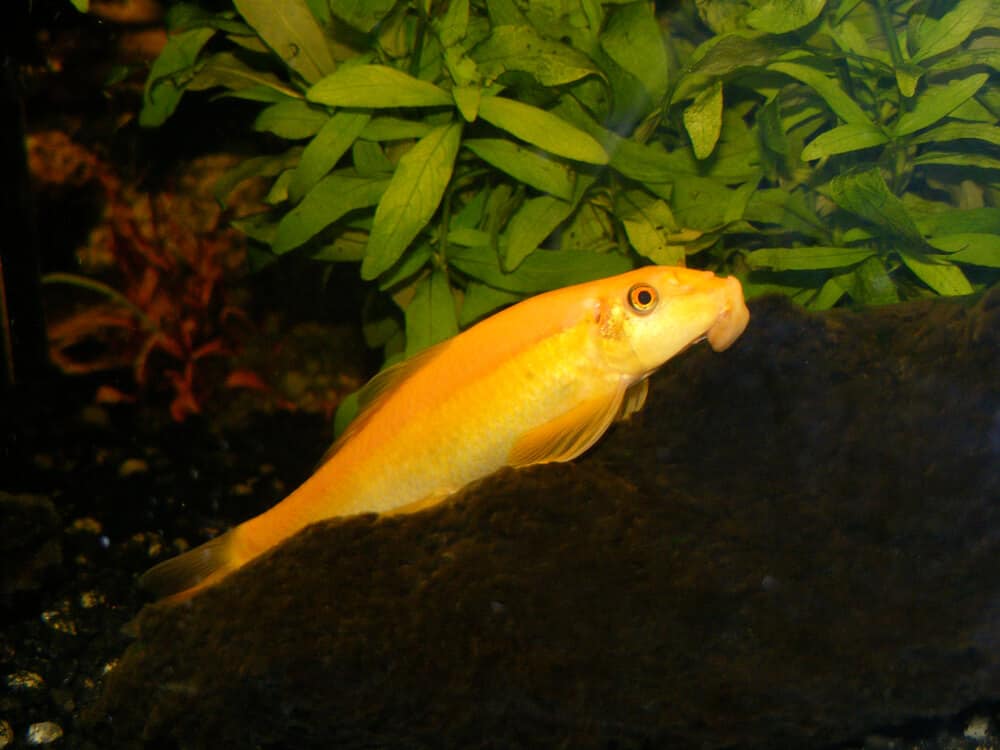
Conclusion
With all the above information about Golden Chinese Algae Eaters laid out for you, at the end of the day, it’s up to you to decide whether they are the right type of fish for you.
Chinese Algae Eaters are a relatively straightforward type of species to care for. The common issue that would turn people off from keeping one as a pet is their aggression which grows worse as they mature.
However, this aggression is only triggered depending on the tank mates you group them with, or if any at all. So, choosing the right tank mates or choosing to keep them in a separate tank should result in a much more peaceful experience with the Golden Chinese Algae Eater.
They’re not only eye-catching and good for livening up a home with their unique and interesting appearance, but they’re also incredibly useful as little helpers for tank maintenance, particularly with algae control. Although they may not be as good as other suckerfish like Plecos, they still get the job done.
They definitely come with their issues but what pet doesn’t? It may not be a more common choice but it can definitely be rewarding, especially for someone who has always had an interest in the species.
